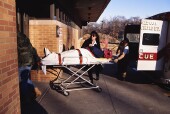- Navigating Your Midlife Crisis: Embracing New Possibilities
- City Raccoons Showing Signs of Domestication
- Mapping the Exposome: Science Broadens Focus to Environmental Disease Triggers
- One Week Less on Social Media Linked to Better Mental Health
- Your Brain Changes in Stages as You Age, Study Finds
- Some Suicide Victims Show No Typical Warning Signs, Study Finds
- ByHeart Formula Faces Lawsuits After Babies Sickened With Botulism
- Switch to Vegan Diet Could Cut Your Greenhouse Gas Emissions in Half
- Regular Bedtime Does Wonders for Blood Pressure
- Dining Alone Could Mean Worse Nutrition for Seniors
Hispanics in U.S. Least Likely to Dial 911 for Stroke


Fewer than two-thirds of patients suffering a stroke in the United States call for emergency assistance, with Hispanics least likely to do so, new research finds.
“These results are not surprising since stroke survivors from minority race and ethnic groups have worse outcomes after stroke compared to non-Hispanic whites,” said study lead author Heidi Mochari-Greenberger, an adjunct associate research scientist at Columbia University Medical Center in New York City.
If you suspect a stroke, it’s critical to call 911 immediately. Stroke treatment must start quickly in order to control brain damage, and research shows that an ambulance ride is the quickest route to treatment, Mochari-Greenberger said.
The researchers launched their study because they wanted to better understand racial and ethnic differences in death and disability rates after stroke, she said. Different levels of ambulance use could play a role, she noted.
Stroke is the leading cause of serious long-term disability and the fourth leading cause of death in the United
States, the researchers said in background notes.
The study — published Aug. 12 in the Journal of the American Heart Association — examined nearly 400,000 stroke patients, average age 71, who visited about 1,600 hospitals in the United States from 2011 to 2014. Of all the patients, 59 percent arrived at the hospital by ambulance.
White women were the most likely to call paramedics, doing so in 62 percent of cases. Hispanic, Asian and black women called for emergency help 56 percent to 58 percent of the time. Among male stroke victims, 57 percent to 58 percent of blacks and whites used an ambulance, but only 52 percent of Hispanic men did so, the study found.
Patients with more obvious symptoms, such as weakness, paralysis or speech difficulties, were also more likely to call for an ambulance than those with subtle signs.
The researchers found that differences remained even after they adjusted their statistics so they wouldn’t be thrown off by factors like severity of stroke symptoms.
It’s not clear, however, if those who found other ways to the hospital fared worse or arrived at the hospital later than those who rode by ambulance. Nor does the study say how people who didn’t use an ambulance got to the hospital. And while they have theories, researchers don’t know why the differences in ambulance use exist.
But the presence of someone else at the time of stroke, ability to speak English and education levels could have played roles, Mochari-Greenberger said.
Dr. Salvador Cruz-Flores, chair of neurology at Texas Tech University Health Sciences Center in El Paso, said the findings matter because stroke is more common among minority groups.
“If one considers that minorities will keep growing, not addressing these differences can lead to a higher death or disability rate in the minorities with the associated financial cost to society,” he said.
Despite the study’s limitations, the findings are “useful to the extent that they give us more evidence of the problem,” Cruz-Flores said. “Now is the time to come up with strategies of intervention to decrease the disparities.”
More information
The American Stroke Association shares stroke warning signs.
Source: HealthDay
Copyright © 2025 HealthDay. All rights reserved.










